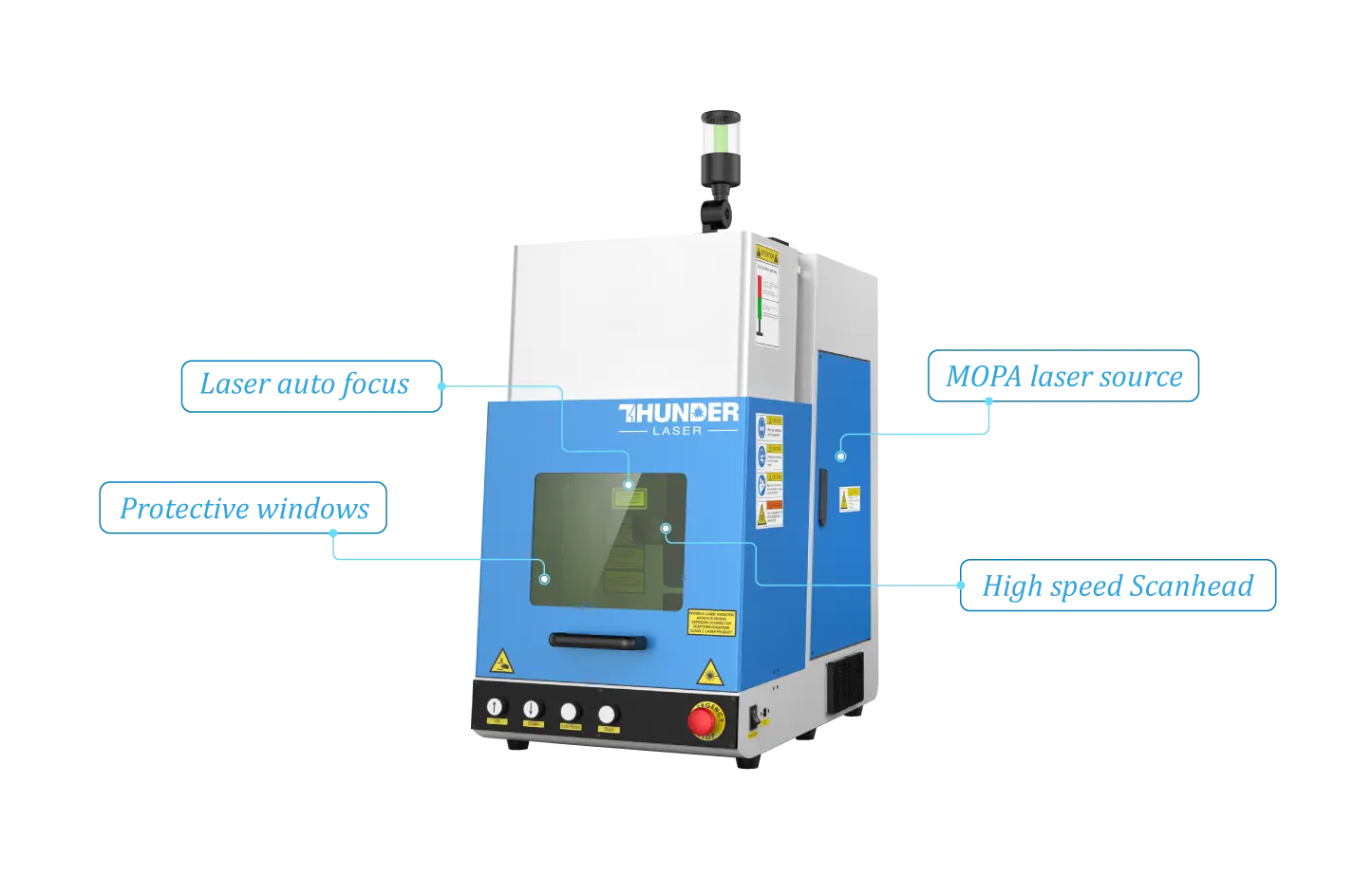The fiber laser marking machine is a revolutionary technology. It creates permanent markings on various materials quickly and effectively. It is a versatile tool widely popular in the manufacturing, automotive, and jewelry industries. Fiber laser marking machine is popular because of their exceptional precision and durability. Therefore, we can not ignore the importance of fiber laser marking machines.
We know that by using a fiber laser marking machine, we can etch intricate designs, logos, barcodes, and texts. Besides, this machine enables the marking of various products in manufacturing industries. Here, marking serial numbers, part identification, and quality control symbols are noteworthy. Therefore, the advantage of using this machine is its ability to create accurate and durable markings.
You already have understood the purpose of this article. It aims to provide a comprehensive guide on using fiber laser marking machines. It covers step by step process from preparation to regular maintenance. Before discussing step by step process, the article introduces 20W, 30W, 50W, and 100W fiber laser marking machines to you.
You can quickly and efficiently handle the device by understanding the proper usage of fiber laser marking machines. You will understand how to create permanent and high-quality markings on various materials. Fiber lasers offer reliable solutions for product identification, branding, or personalization.
What can you do with a fiber laser marking machine?

Whenever we discuss laser marking, the importance of fiber laser marking machines comes first. You can consider 20W, 30W, 50W, and 100W fiber lasers. These are the most popular fiber laser marking machines you may find best for your project.
20W fiber laser marking machine can mark on both metals and non-metals. Although the marking depth is not deep, it can be cost-effective. On the other hand, a 30W fiber laser marking machine creates deeper marking than 20W fiber lasers. It can also be a cost-effective solution. These devices suit part marking, jewelry engraving, and electronics component marking.
50w fiber laser marking machine provides a deeper marking solution than the above two devices. 50W or 100W fiber laser marking machine is suitable for deep engraving applications. Creating signage and heavy metal engraving like stainless steel are some popular applications. While choosing between these two devices, consider a 50W Raycus fiber laser marking machine. This device can fulfill all your marking requirements. Besides, the 50w fiber laser marking machine price is also within the budget. You can use a 100W fiber laser marking solution if you have deeper marking requirements.
Above all, if you are a beginner, we suggest better go for 20 watt fiber laser marking machine or 30 watt fiber laser marking machine. These two devices can laser mark popular materials you may need. Besides, the 20W fiber laser marking machine price is cheaper. Therefore, this model is the best fiber laser marking machine for beginner’s projects.
How to use fiber laser marking machine
Using a fiber laser marking machine correctly is essential to achieve optimal results. Understanding the importance of using the device is crucial for maximizing its capabilities. In the following, we will explore a step-by-step guide on how to use a fiber laser marking machine. Each step will cover essential aspects of the entire process. By following these steps, you can unlock the full potential of your fiber laser marking machine.
Step 1: Preparation
Preparation in every operation is necessary to ensure a safe and organized workspace. Regarding laser marking, proper preparation sets the foundation for successful marking. It also minimizes the risk of accidents or errors.
First, clean the working area thoroughly. Debris, dust, or obstruction interferes with the machine’s operations. They also affect the quality of the markings. A clean work area reduces material contamination. Besides, a clean work area maintains your machine’s longevity. Next, ensure your device is in the correct place on a stable surface. It is necessary to prevent vibrations or movements during the marking process. It is important to note that vibrations may lead to inaccurate or distorted markings.
Once the working area is ready, secure the material to be marked. You can use a magnet for flat materials like metal sheets. You could use a clamp to secure plastic panels in place. For irregular surfaces, you could use custom jigs or fixtures.
Step 2: Set up
Once you prepare the working area, you should properly set up your fiber laser marking machine. First, ensure you have connected your laser device with a stable and appropriate power source. In this case, you must follow the manufacturer’s instructions and guidelines. This step is necessary to ensure uninterrupted operation during the marking process.
Next, install the required software and drivers on the computer connected to your laser device. This software controls the marking parameters. It also imports designs or text and adjusts the settings for different materials. Therefore, choosing the right software is necessary. In this case, you can seek assistance from the manufacturer. Thunder Laser suggests EZCad 2 and EZCad 3 software for all their fiber laser marking machines.
After installing the right software, configure the settings based on the material and the desired marking depth. Configuring the settings includes adjusting the focal length and position of the laser beam. The correct power levels, speed, and laser beam position ensure precise alignment with the desired marking area. Overall, it enhances the overall accuracy of the process.
Step 3: Marking Process
Once your laser machine is appropriately set up, follow the proper steps for the actual marking process. First, import the desired design, text, or barcode into the software (EZCad or Light Burn). The laser software is generally compatible with standard image formats (bmp, jpg, gif, tga, png, and tif). After importing the file, make sure you positioned the design correctly. Besides, you should also scale the design with the software to align with the desired marking area on the material.
Next, set the appropriate laser power, marking speed, and other parameters based on the specified material. Different materials have varying absorption and thermal conductivity properties. Therefore, proper adjustments are required to achieve optimal results. In this case, you can consult the machine’s user manual or seek expert advice to determine the suitable settings.
Above all, remember to exercise caution and follow safety guidelines when operating your laser machine. Wear safety glasses to protect your eyes from laser radiation.
Step 4: Finishing
After your laser machine completes marking, it’s essential to consider the finishing touches. This step is necessary to enhance the overall appearance and durability of the marked surface.
First, conduct the visual inspection for quality, accuracy, and depth. Carefully examine the marked surface under appropriate lighting conditions. This step is necessary to ensure clear and legible markings that meet the desired specifications. You can also check for any inconsistencies, errors, or imperfections.
If you notice any debris or residue on the marked surface, remove it using suitable cleaning methods. We recommend using non-abrasive and non-damaging cleaning agents and tools. Choosing these agents and tools is necessary to avoid damaging or altering the markings. Consider using lint-free cloths, alcohol wipes, or specialized cleaning solutions. In this case, you can follow the manufacturer’s or supplier’s instructions for guidelines. Sometimes you may need additional post-processing steps to achieve the desired final appearance.
Step 5: Maintenance
This last step is usually not the latest in the marking process. Instead, proper maintenance determines your laser machine’s overall performance and longevity. This step focuses on three key aspects: cleaning the lens, replacing the consumable parts, and keeping the updated software.
Regular cleaning involves removing dust or debris from your laser machine and its components. Over time these residues can accumulate on these components. This accumulation affects the quality and accuracy of the laser beam. Use appropriate cleaning tools and methods recommended by the manufacturer. It is important to note that abrasive materials or harsh chemicals could damage the surface.
In addition to cleaning, replacing consumable parts as the manufacturer recommends is essential. For example, protective filters can degrade over time. Regular replacement ensures that your laser machine operates at its peak efficiency. Furthermore, keeping the software updated is crucial to enhancing functionality and performance. Regularly check for updates and install them as recommended by the manufacturer.
Regular maintenance practices maximize the lifespan and performance of your laser machine. It ultimately ensures consistent and high-quality results for your marking needs.
Expert Advice
In the discussion above, we have discussed some of the general steps in using a laser machine. You can get the desired results from your laser machine by following these steps. Yet, experience and work tricks can make more accurate results. Here are some expert tips that you can follow. These tips ensure safety, maintain quality and enhance your machine’s productivity.
- First, understand your fiber laser marking machine. Read its manual and attend the manufacturer’s training sessions. You can also consult with technical experts to familiarize yourself with its operation.
- Different materials require different laser settings. Therefore, get used to the material compatibility charts. In this case, you can also seek expert advice to determine the appropriate laser settings.
- Before performing the final marking, conducting a test run and optimizing the settings is always wise. We recommend this step, especially for beginners. Doing this allows you to fine-tune the machine’s settings. It also minimizes the risk of errors or wasted materials.
- Fiber laser marking machines may emit laser beams that can be hazardous if not used properly. Therefore, wear protective equipment during the operation.
- Regular maintenance and calibration of your laser machine are the keys to your machine’s extended lifespan. It also reduces the risk of downtime and costly repairs.
- Keep a record of the machine’s settings and material parameters. This documentation acts as a reference for future projects.
Above all, don’t hesitate to contact experts if you encounter challenges. Thunder Laser is a famous China fiber laser marking machine manufacturer worldwide. They can provide valuable insights, tips, and solutions. These support solutions can help you overcome obstacles and achieve optimal results.


.png) International
International
 United States
United States
 Brasil
Brasil
 Canada
Canada
 Costa Rica
Costa Rica
 Česká
Česká
 Ελλάδα
Ελλάδα
 Polska
Polska
 Ireland
Ireland
 Portugal
Portugal
 Lietuva
Lietuva
 Россия
Россия Deutschland
Deutschland
 Britain
Britain
 Україна
Україна
 France
France
 Sverige
Sverige
 Italia
Italia
 Norway
Norway
 Denmark
Denmark
 Romania
Romania
 한국
한국
 中国
中国
 ประเทศไทย
ประเทศไทย
 中国香港
中国香港
 Israel
Israel
 中國臺灣
中國臺灣
 India
India
 پاکستان
پاکستان
 پශ්රී ලංකා
پශ්රී ලංකා
 Australia
Australia
 New Zealand
New Zealand
 South Africa
South Africa